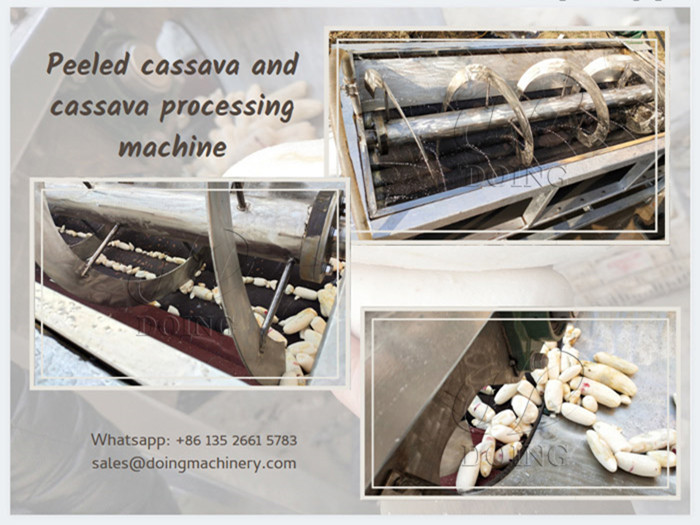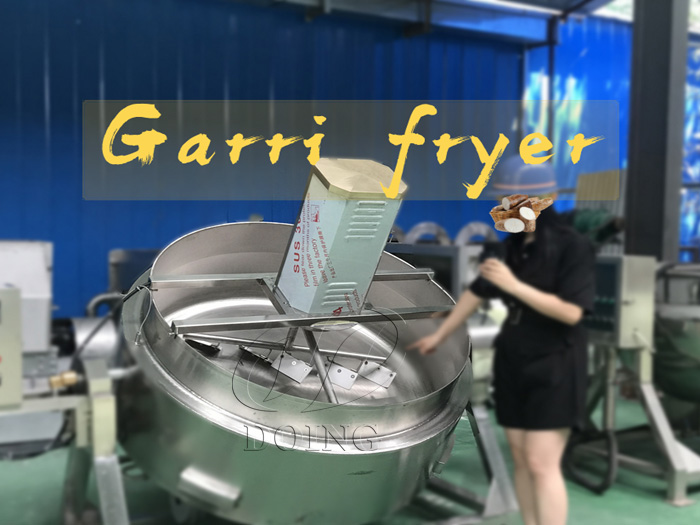Blog
 2025-07-30
2025-07-30Garri, is produced through a series of sophisticated processes that require precision and efficiency. The industrial production of garri involves several critical steps, among which peeling, dehydration, and frying stand out as the most technologically demanding. Henan Jinrui Food Technology Co., Ltd. has pioneered advancements in garri processing area, offering equipment that significantly enhances productivity, quality, and safety.
This article explores the key technological breakthroughs in these three steps: peeling, dehydration and frying, highlighting the advantages of Jinrui’s equipment as derived from the garri production line summary.
1. Peeling: Achieving High Efficiency and Hygiene
Peeling is the critical step in garri production, where the outer layer of cassava roots is removed to eliminate impurities and reduce toxicity. Traditional peeling methods are often inefficient and can result in incomplete peeling or damage to the cassava pulp. To address this challenge in garri industrial production, Henan Jinrui has introduced the peeling machine. Through its innovative design, this machine has achieved a technological breakout in peeling for industrial garri production:
 Cassava Peeling Machine
Cassava Peeling Machine
- Sand Roller Peeling Technology: The machine employs sand rollers wrapped in waterproof sandpaper, which improves the peeling efficiency and ensures the peeling effect, with a peeling rate of up to 90-95%. Compared with traditional manual peeling, more cassava peeling can be processed in the same time, improving the industrial production efficiency of garri.
- Hygienic Design: The machine includes a residue collection system to prevent splashing of wastewater and peels, ensuring a cleaner working environment. In addition, Henan Jinrui's peeling machine is equipped with a spraying device that can rinse the peeled cassava to ensure the peeling effect of the cassava.
- Durability and Maintenance: Unlike competitors using plastic or stainless steel brushes (which wear out quickly or pose food safety risks), Jinrui’s sand rollers are replaceable. Only the sandpaper needs periodic replacement, reducing long-term costs and downtime for garri industrial production.
These advancements ensure high peeling rates, minimal waste, and compliance with food safety standards, Henan Jinrui’s peeling equipment achieves technological breakout in peeling stage for garri industrial production!
2. Dehydration: Precision and Energy Efficiency
After peeling and grating, the cassava pulp undergoes dehydration to reduce moisture content. Industrial garri production has very high requirements for dehydration technology and requires precise control of the moisture content, which is also crucial to the quality of garri. In traditional garri production, people often dehydrate the crushed cassava by manual squeezing or using simple tools at home, but this is unhygienic and will result in poor quality of garri. In order to meet the needs of industrial production of garri, Henan Jinrui has designed a hydraulic press that can achieve autonomous dehydration and control the optimal moisture content (38-40%), breaking through the bottleneck of dehydration technology in industrial production of garri:
 Hydraulic press
Hydraulic press
- Optimal Moisture Content: The press efficiently extracts water, ensuring the pulp reaches the ideal moisture level for frying. Henan Jinrui's hydraulic press improves the quality and efficiency of industrial garri production by optimizing dehydration technology!
- Dual-Chamber Design: The press consists of two barrels, with the outer barrel serving as a containment unit for cleanliness. The sliding mechanism on both sides facilitates easy loading and unloading, achieving automation in the hydration stage.
- User-Friendly Operation: The hydraulic system is driven by an oil pump, and the inclusion of a water collection tray beneath the press simplifies maintenance.
Compared to conventional methods, Jinrui’s hydraulic press, the breakout of dehydration technology, ensures consistency, energy savings, and higher product quality in garri industrial production.
3. Frying: Uniform Heating and Advanced Control
Frying is the most complex step in garri production, determining the ultimate quality. Traditional garri production often involves manual frying, which is not only inefficient and increases labor costs, but most importantly, the quality of the garri cannot be guaranteed. Facing the various challenges of manual frying, Henan Jinrui has manufactured a frying machine using cutting-edge innovative technology to address common issues such as uneven heating, sticking, and low efficiency, achieving a technological breakout in garri frying and better meeting the needs of garri industurial production:
 Garri fryer
Garri fryer
- Automated Controls: The machine is equipped with variable frequency speed regulator for adjustable stirring speed and temperature settings. The tilting mechanism, driven by rack and pinion structure, simplifies discharging and reduces labor intensity, increasing the efficiency of garri industrial production.
- Eccentric Stirring Mechanism: The double-axis system—comprising a large axis for revolution and a small axis for rotation—ensures uniform stirring without dead corners. This prevents burning and guarantees even heat distribution, ensuring the quality of garri production.
- Thermal Oil Heating: The frying machine features a double-layer sandwich filled with heat transfer oil, which provides stable and adjustable temperatures. The oil’s high auto-ignition point (above 100°C) enhances safety, while the sealing structure prevents leaks and maintains hygiene.
These features collectively ensure high production efficiency, consistent product quality, and operational safety, setting Jinrui’s garri fryer apart from competitors.
The industrial production of garri hinges on the effectiveness of peeling, dehydration, and frying technologies. Henan Jinrui has demonstrated leadership in these areas by developing equipment that combines innovation, efficiency, and reliability. From the high-peeling-rate sand rollers to the precision dehydration press and the advanced frying system, Jinrui’s solutions address the core challenges of garri production. These breakouts not only enhance productivity but also ensure the final product meets the highest standards of quality and safety, solidifying Jinrui’s position as a trusted partner in the garri processing industry. If you also want to create more profits by high efficiency and high quality of garri production, Henan Jinrui garri processing machine is your best choice! Welcome to contact us!
Want to know more about our products or services? Fill out the contact form below, and we’ll to get back to you and you will get the price list. Please also feel free to contact us by email or phone.( * Denotes a required field).